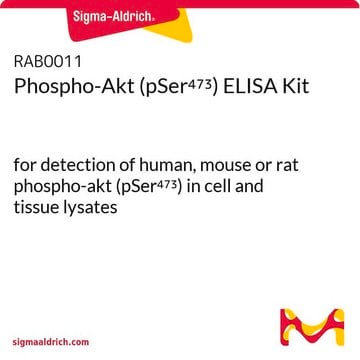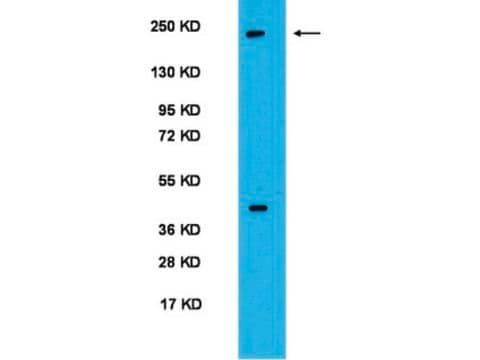AB1665
Anti-Fas Ligand Antibody
serum, Chemicon®
Sinonimo/i:
FasL
Autenticatiper visualizzare i prezzi riservati alla tua organizzazione & contrattuali
About This Item
Codice UNSPSC:
12352203
eCl@ss:
32160702
NACRES:
NA.41
Prodotti consigliati
Origine biologica
rabbit
Forma dell’anticorpo
serum
Tipo di anticorpo
primary antibodies
Clone
polyclonal
Reattività contro le specie
mouse, rat
Non deve reagire con
human
Produttore/marchio commerciale
Chemicon®
tecniche
ELISA: suitable
western blot: suitable
N° accesso NCBI
N° accesso UniProt
Condizioni di spedizione
dry ice
modifica post-traduzionali bersaglio
unmodified
Informazioni sul gene
human ... FAS(355)
Immunogeno
An 18 amino acid peptide sequence (aa 130-146) from rat FASL. This sequence is known to be 94% homologous with mouse FASL, differing by one amino acid. This peptide region does not show significant homology with human FASL, with only four amin
Applicazioni
Detect Fas Ligand using this Anti-Fas Ligand Antibody validated for use in ELISA & WB.
Research Category
Apoptosis & Cancer
Apoptosis & Cancer
Research Sub Category
Apoptosis - Additional
Apoptosis - Additional
Western blotting:1:1000 - 1:5,000, using Chemiluminescent detection. The use of 0.1 - 0.5% milk in diluents is recommended to reduce background. Based upon the calculated amino acid sequences, rat (278), mouse (279), and human (281) FASL has a molecular weight of ~32 kDa. A 40 kDa FASL band has been detected in mouse T cells.
ELISA: 1:10,000 - 1:50,000, for detection of control peptide (AG626) coated at a 1 μg/mL concentration.
Optimal working dilutions must be determined by end user.
ELISA: 1:10,000 - 1:50,000, for detection of control peptide (AG626) coated at a 1 μg/mL concentration.
Optimal working dilutions must be determined by end user.
Stato fisico
Liquid antiserum containing 0.05% sodium azide as a preservative.
Stoccaggio e stabilità
Store at -20°C for up to 12 months in undiluted aliquots. Avoid repeated freeze-thaw cycles.
Note legali
CHEMICON is a registered trademark of Merck KGaA, Darmstadt, Germany
Esclusione di responsabilità
Unless otherwise stated in our catalog or other company documentation accompanying the product(s), our products are intended for research use only and are not to be used for any other purpose, which includes but is not limited to, unauthorized commercial uses, in vitro diagnostic uses, ex vivo or in vivo therapeutic uses or any type of consumption or application to humans or animals.
Not finding the right product?
Try our Motore di ricerca dei prodotti.
Codice della classe di stoccaggio
10 - Combustible liquids
Classe di pericolosità dell'acqua (WGK)
WGK 1
Certificati d'analisi (COA)
Cerca il Certificati d'analisi (COA) digitando il numero di lotto/batch corrispondente. I numeri di lotto o di batch sono stampati sull'etichetta dei prodotti dopo la parola ‘Lotto’ o ‘Batch’.
Possiedi già questo prodotto?
I documenti relativi ai prodotti acquistati recentemente sono disponibili nell’Archivio dei documenti.
Gabriella Brunlid et al.
Stem cells (Dayton, Ohio), 25(10), 2551-2558 (2007-07-07)
The potential of pluripotent embryonic stem (ES) cells to develop into functional cells or tissue provides an opportunity in the development of new therapies for many diseases including neurodegenerative disorders. The survival of implanted cells usually requires systemic immunosuppression, however
Il team dei nostri ricercatori vanta grande esperienza in tutte le aree della ricerca quali Life Science, scienza dei materiali, sintesi chimica, cromatografia, discipline analitiche, ecc..
Contatta l'Assistenza Tecnica.





